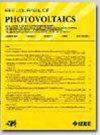太阳能电池金属化磨损对加载频率敏感
IF 2.6
3区 工程技术
Q3 ENERGY & FUELS
引用次数: 0
摘要
我们对预制裂纹硅电池的光伏层压板进行了循环加载,以探索加载频率和接触压力是否以及如何影响随后的网格线磨损过程。采用层压单元片上裂纹网格线上平行电阻的测量作为网格线电接触退化的度量。实验结果的方差统计分析(ANOVA)分析发现,加载频率比接触压力对网格线退化的影响更显著。本文章由计算机程序翻译,如有差异,请以英文原文为准。
Solar Cell Metallization Wear is Sensitive to Loading Frequency
We performed cyclic loading of photovoltaic laminates with precracked silicon cells to explore if and how loading frequency and contact pressure influence the ensuing gridline wear-out process. A measurement of parallel resistance across cracked gridlines on a laminated cell coupon was used as the metric for gridline electrical contact degradation. A statistical analysis of variance (ANOVA) analysis of the experimental results discerned that loading frequency is a more significant factor than contact pressure for gridline degradation.
求助全文
通过发布文献求助,成功后即可免费获取论文全文。
去求助
来源期刊

IEEE Journal of Photovoltaics
ENERGY & FUELS-MATERIALS SCIENCE, MULTIDISCIPLINARY
CiteScore
7.00
自引率
10.00%
发文量
206
期刊介绍:
The IEEE Journal of Photovoltaics is a peer-reviewed, archival publication reporting original and significant research results that advance the field of photovoltaics (PV). The PV field is diverse in its science base ranging from semiconductor and PV device physics to optics and the materials sciences. The journal publishes articles that connect this science base to PV science and technology. The intent is to publish original research results that are of primary interest to the photovoltaic specialist. The scope of the IEEE J. Photovoltaics incorporates: fundamentals and new concepts of PV conversion, including those based on nanostructured materials, low-dimensional physics, multiple charge generation, up/down converters, thermophotovoltaics, hot-carrier effects, plasmonics, metamorphic materials, luminescent concentrators, and rectennas; Si-based PV, including new cell designs, crystalline and non-crystalline Si, passivation, characterization and Si crystal growth; polycrystalline, amorphous and crystalline thin-film solar cell materials, including PV structures and solar cells based on II-VI, chalcopyrite, Si and other thin film absorbers; III-V PV materials, heterostructures, multijunction devices and concentrator PV; optics for light trapping, reflection control and concentration; organic PV including polymer, hybrid and dye sensitized solar cells; space PV including cell materials and PV devices, defects and reliability, environmental effects and protective materials; PV modeling and characterization methods; and other aspects of PV, including modules, power conditioning, inverters, balance-of-systems components, monitoring, analyses and simulations, and supporting PV module standards and measurements. Tutorial and review papers on these subjects are also published and occasionally special issues are published to treat particular areas in more depth and breadth.
 求助内容:
求助内容: 应助结果提醒方式:
应助结果提醒方式:


